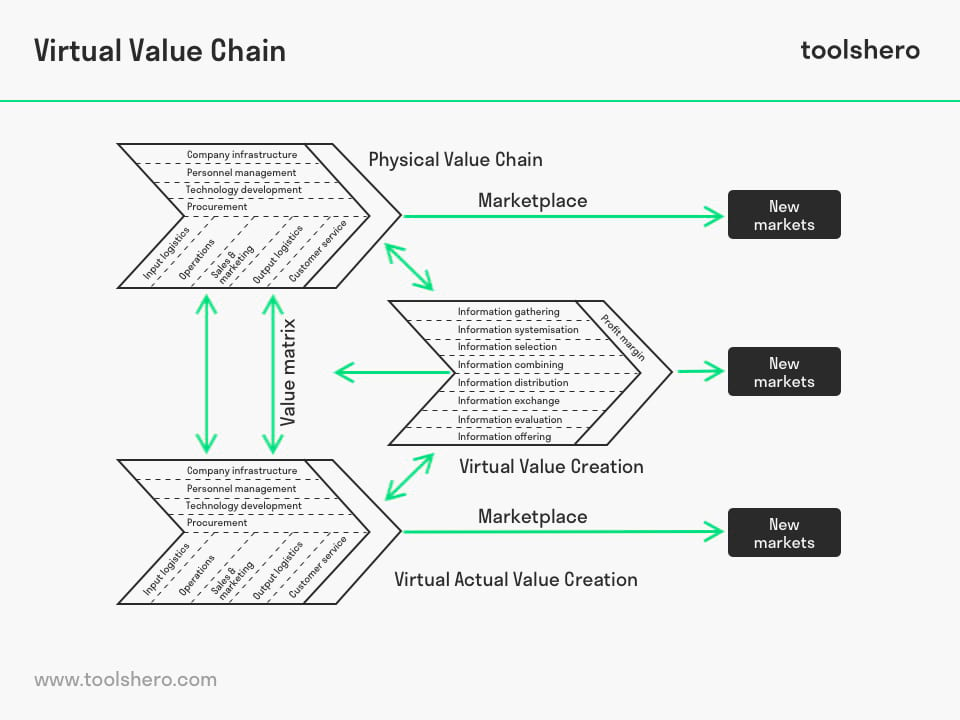Virtual Value Chain Model

Virtual Value Chain Model: this article explains the Virtual Value Chain Model in a practical way. After reading you will understand the basics of this powerful problem solving tool.
What is the Virtual Value Chain Model?
Today’s organizations are dealing with digital information provision and this has created another approach to customers, suppliers and business partners.
In addition to the physical market, the abstract market is becoming more and more important. To understand and get a grip of the interaction between these two markets, John Sviokla and Jeffrey Rayport created the Virtual Value Chain model.
What is the Virtual Value Chain?
The Virtual Value Chain (VVC) works like a business model and describes the dissemination of value generating services within an “Extended Enterprise”; an organization that cooperates closely with other organizations to provide services or products.
The VVC begins with the information provided by the provider. Then this information is distributed and supported throughout the information-infrastructure whereupon the real interaction with the customer/end user follows.
Two separate value chains
As both the market place (that is physically present) and the abstract market space (virtual) need to be managed in different ways to be effective and efficient, the value chain is separated into two chains.
Nonetheless this linkage between the two is crucial for an effective management value chain. Many businesses use these value chains such as banks that provide services to customers in the physical word (at their branch offices) and in the virtual world (online services).
Different approach
Michael Porter stated the internet as such does not add value to the VVC but it should be incorporated as a factor into this business model. The Internet affects all primary activities within an organization.
In addition, all products and services a company supplies need to conform to the distribution and information channel that is in keeping with the customer’s needs. Control of this channel is part of the company’s strategy. In the virtual value chain all information is a dynamic element and the information is used to generate innovative concepts. This may create new value for the customer.
Five elements
In the Virtual Value Chain the information in the abstract market space is applied in a series of steps. Creating knowledge and adding value comprise five elements: gathering, organization, selection, analysis and distribution.
These five elements enable organizations to generate new markets and build up new business relationships. The entire process turns raw data into valuable information.
Network management
New technological developments in IT can lead to drastic changes in the ways organizations operate. Important business is managed by IT and value adding within the virtual value chain can only be achieved by using IT. In order to implement this properly, Mary Cronin distinguishes three important elements within the virtual value chain:
1. Input from the supplier
All information about and from the supplier will make an important contribution to value adding.
2. Internal operations
Information about effective procurement is of inestimable value for a business. Global distribution of information saves costs.
3. Customer Relations Management (CRM)
Directly adding information in the CRM system about the customer’s needs as a value will help improve the product or service immediately.
Management
It is essential that managers understand the realization of value in both the physical and virtual market space within the Virtual Value Chain. They will gain a clearer insight into their strategy by construing the differences between the values and by adding value to the interactions within the values. By being open to the interaction between the physical market and the abstract market space, managers are better able to integrate all valuable digital information as a result of which they can enhance their competitive position.
It’s Your Turn
What do you think? Is the Virtual Value Chain model applicable in today’s modern economy and marketing? Do you recognize the practical explanation or do you have more suggestions? What are your success factors for the good digital activity management?
Share your experience and knowledge in the comments box below.
More information
- Cronin, M. J. (1995). Doing more business on the Internet. John Wiley & Sons, Inc.
- Hagel, J., & Rayport, J. F. (1997). The coming battle for customer information. McKinsey Quarterly, 64-77.
- Klobas, J. (1998). The virtual supply chain: a view of information flows, business structures and business opportunities. Business Information Review, 15(3), 185-192.
- Rayport, J. F. (1999). The truth about Internet business models. Strategy and Business, 5-7.
- Rayport, J. F., & Jaworski, B. J. (2005). Best face forward: Why companies must improve their service interfaces with customers. Harvard Business Press.
- Rayport, J. F. & Sviokla, J. J. (1995). Exploiting the virtual value chain. Harvard Business Review, 73(6), 75.
How to cite this article:
Van Vliet, V. (2010). Virtual Value Chain model. Retrieved [insert date] from Toolshero: https://www.toolshero.com/problem-solving/virtual-value-chain/
Published on: 10/14/2010 | Last update: 07/03/2022
Add a link to this page on your website:
<a href=”https://www.toolshero.com/problem-solving/virtual-value-chain/”>Toolshero: Virtual Value Chain model</a>













